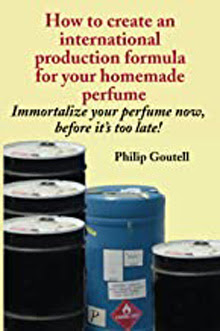 |
| Weighing 10 ml of "Confusion II" |
This article is a continuation of my previous post.
In front of me I have a bottle holding a small batch of a new perfume, "Confusion II." I'm working a plan to market it in a particular niche which, hopefully, will be nicely profitable. I've settled on the number of bottles I want to produce initially to test the market and my marketing concept. Now I need to produce the perfume.
You may think this is the easy part and, in a way, it is. Once the formula has been developed, the rest is pretty mechanical. But it is also where serious money will be spent. Don't believe those who tell you that the fragrance in the bottle costs next to nothing. For a small company buying aroma materials in small quantities, what goes into the bottle costs plenty.
So it's important to match the amount of fragrance being produced with the needs of the project. Produce too much fragrance and you eat up the profits from what you sell. Accurate calculations are important.
First off, how many bottles do you want to fill and how much fragrance will be needed to fill those bottles?
Suppose I want to fill 300 bottles, a small enough quantity that I can easily do by hand. And say I'm working with one ounce bottles, bottles that hold 1 fluid ounce which is about 29 ml.
So I'll need (300 x 29) or 8700 ml -- 8.7 liters -- of the finished perfume to fill my 300 bottles.
But I'll add another 100 ml to allow for spills and waste. My hand is reasonably steady but I know from experience that there will be spills and waste and I don't want to find, after all my bottles are lined up, that I only have enough fragrance to fill say 285 bottles -- meaning I'll now have to make a whole new batch of the perfume just to fill those additional 15 bottles.
So for this example I'll need 8800 ml -- 8.8 liters -- of perfume to fill my bottles. But now look at the composition of the perfume. Say I decide to use the fragrance at 10% -- an eau de cologne strength -- which means I'll only need 880 ml (0.88 liters) of fragrance itself and then 7920 ml -- 7.92 liters -- of alcohol. (The alcohol here may be a 90% alcohol -- 180 proof -- with 10% being water to 90% alcohol.)
So I get ready to produce 880 ml of my fragrance. But wait. I developed my formula by WEIGHT. To calculate how much I'll need I have to determine what 880 ml of this particular formula will weigh. It's time to get out the scale.
In the photo above, 10 ml of fragrance are being weighed. The weight for 10 ml of this particular fragrance, my "Confusion II," is 9.55 grams. This means 1000 ml -- one liter -- will weigh 955 grams or 0.955 kilos.
So in order to produce the approximately one liter of fragrance needed to fill 300 1-fluid ounce (29 ml) bottles with "Confusion II" at 10% fragrance, the balance being alcohol and water, I would need to produce, by weight, 0.955 kilos of "Confusion II."
Now, working with my formula which shows the percentage, by weight, of each required material, I can calculate the weight that will be needed of each.
The rest is simple. Weight out the materials and combine them. Give the perfume one to four weeks to become well blended. Then, by nose, make sure it smells right. If all is okay, add the required alcohol and water and let it blend for another one to four weeks. Then it can be bottled and sold.
These are the steps needed to convert your perfume formula measured in drops to a formula measured by weight that can easily be used to produce as much of your perfume as you want.


Convert Liters to Gallons, Volume Conversions.
ReplyDeleteThis was incredibly helpful, thank you Philip!
ReplyDeleteHi Philip,
ReplyDeleteThank you so much for this awesome post. What I am wondering is that I have started creating my formulas based on drops (1 by 1) and just doing 1 fragrance at a time. How do I convert this to ml (to get an estimate of how much oil to order) and then secondly converting those drops to gms?
Thank you so much!
Lui
Hi, Lui -- take a look at this video and see if it helps:
Deletehttp://www.perfumeprojects.com/videos/how-to-use-electronic-balance.shtml
-- Phil